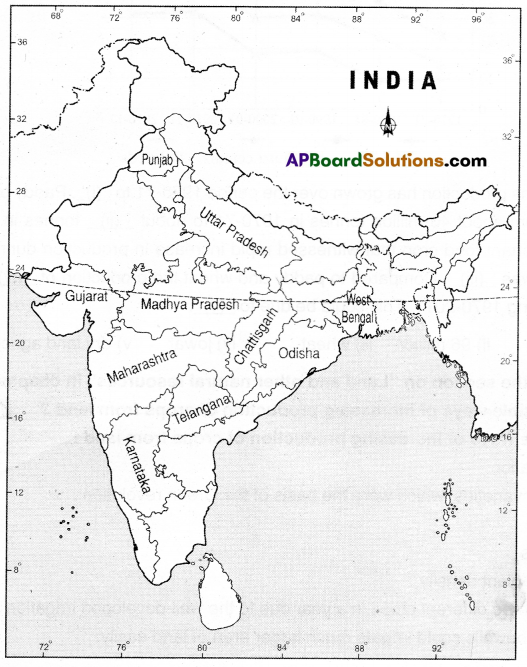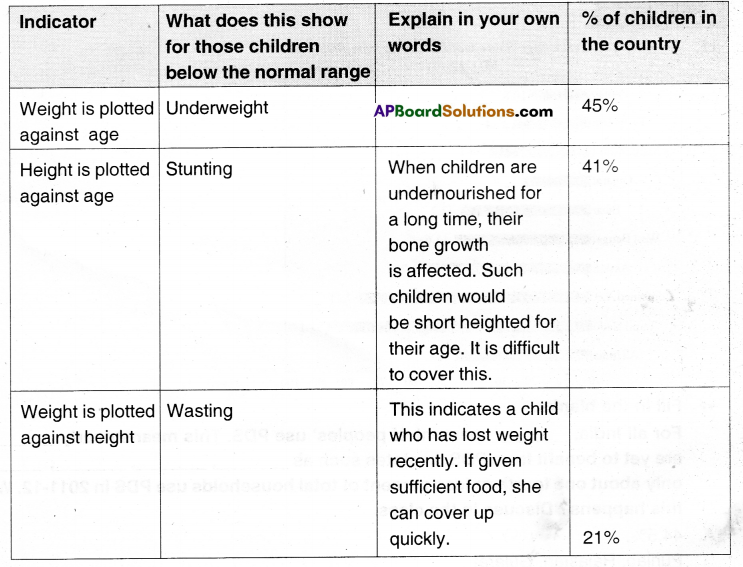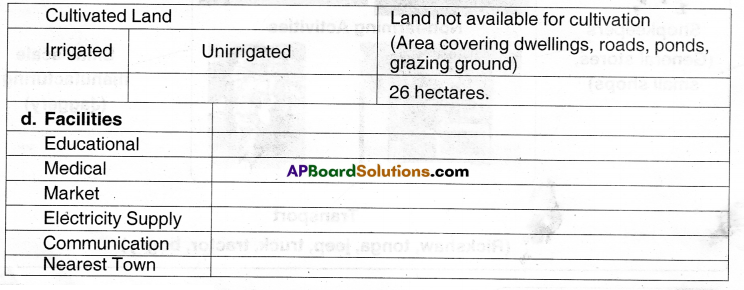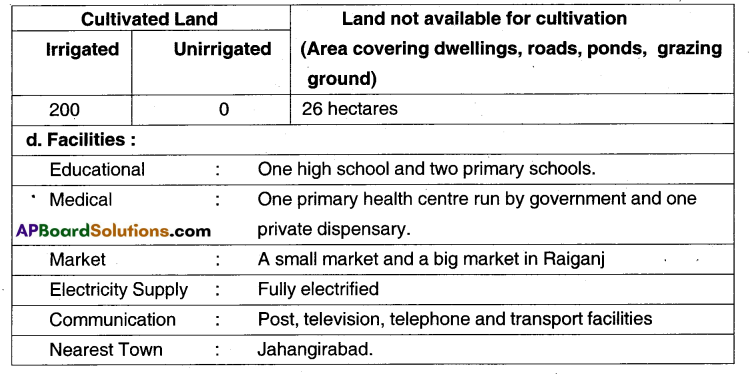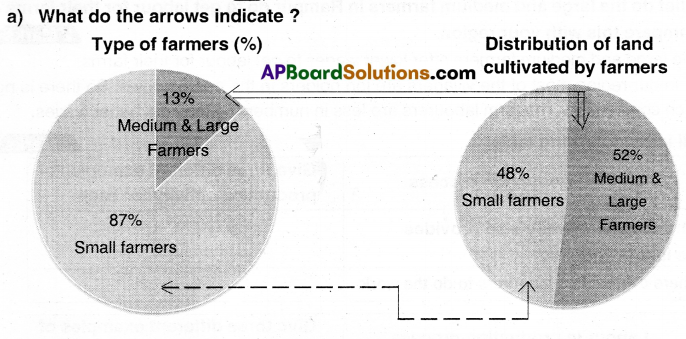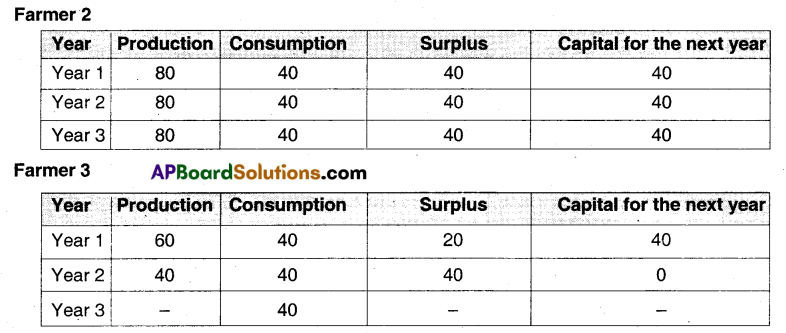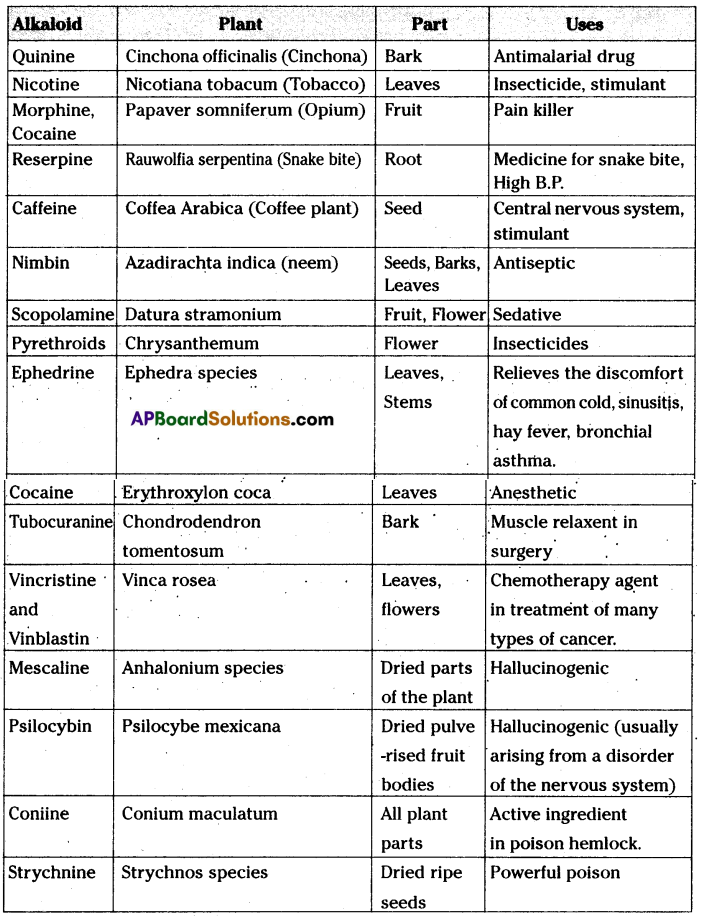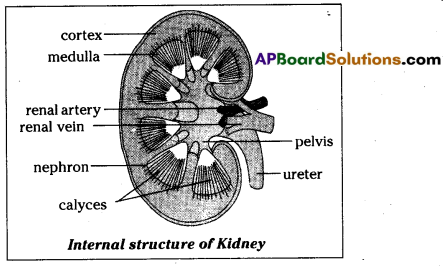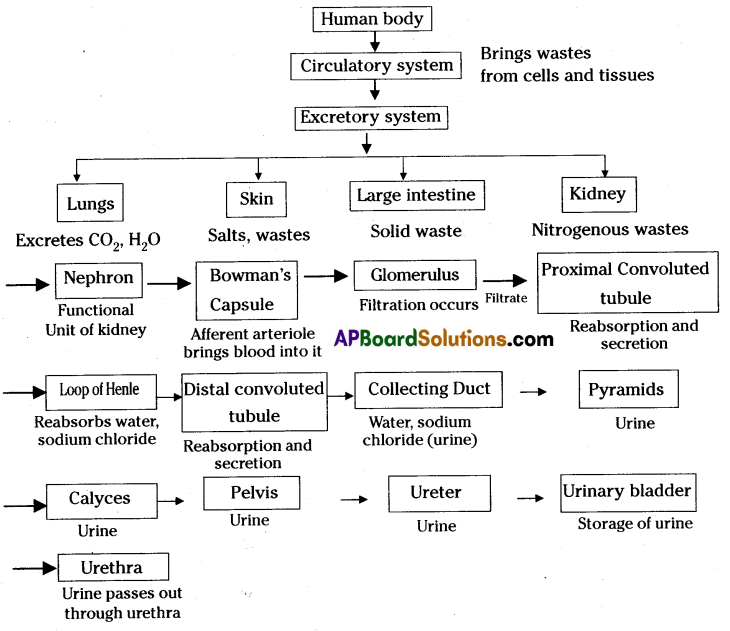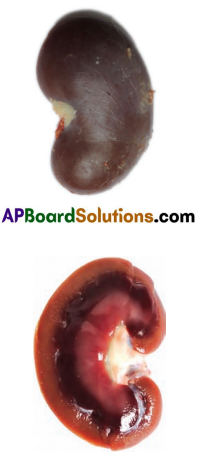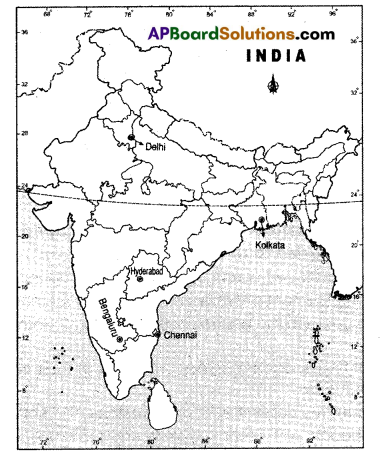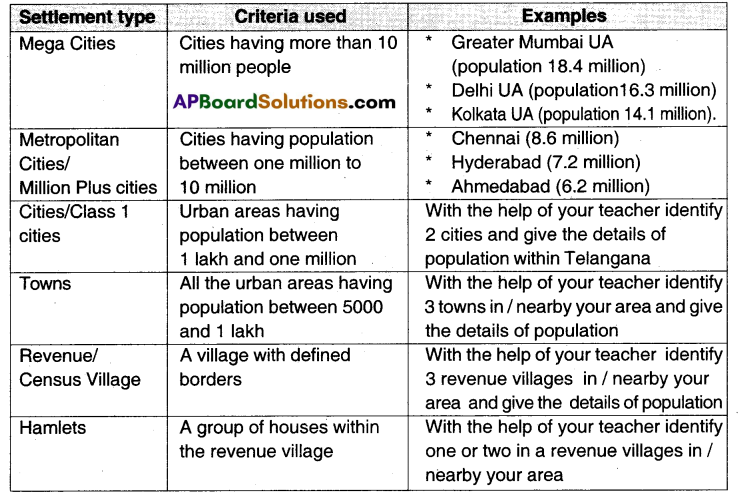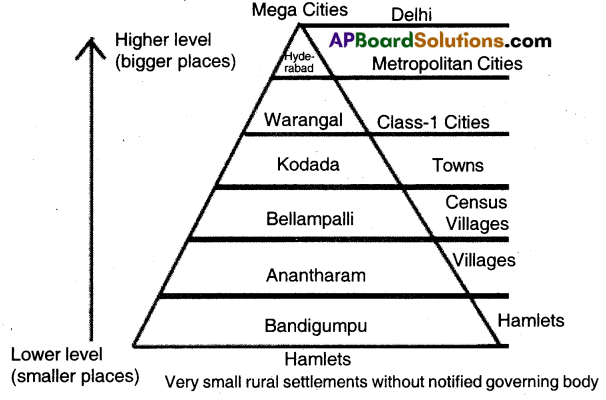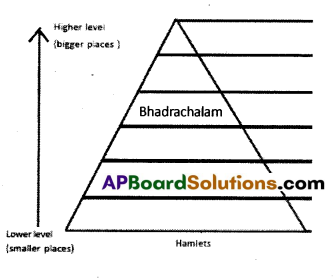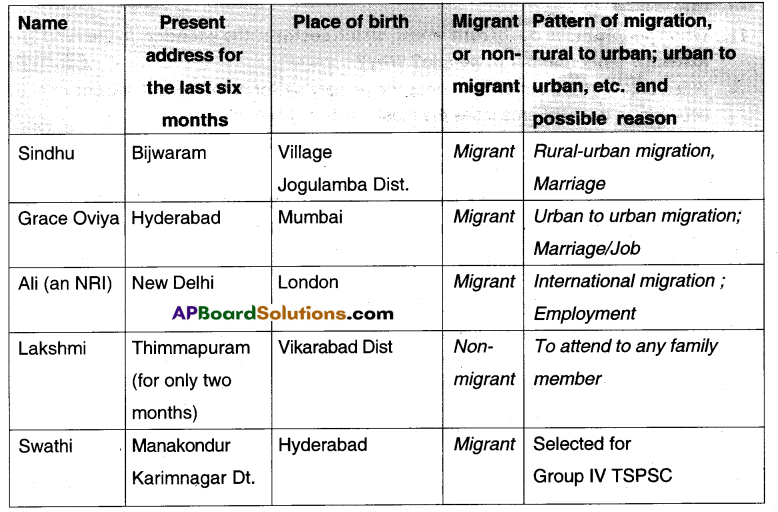These TS 10th Class English Important Questions 5th lesson Social Issues will help the students to improve their time and approach.
TS 10th Class English Important Questions 5th lesson Social Issues
Section – A : Reading Comprehension
(Q.1 – 7)
(A) Read the following passage.
There was something really wrong with the State Transport bus. It had come up the winding road in the mountain as if with a life-time effort. The road was now down-hill and yet the bus moved as slowly as a sick man walking with the help of another. It reached the plain where the dispensary building was situated, and stood still, like an obstinate bull. Now, the destination was hardly a mile or two away. But the driver was sore and the conductor had no option but to be silent. When they realized that the bus wouldn’t move any faster, a couple of passengers exclaimed: “Goddammit for a bloody nuisance!”
The conductor asked the passengers to get down and they all put their strength together to push the bus. Having gained this initial momentum, the bus started. Passengers clambered up, jostling one another. The conductor rang the bell and the bus gradually took on speed. It entered the village reluctantly like a truant child being dragged to school.
As it wound its way through the curves on the outskirts, it groaned and croaked like a hen about to lay eggs, and stopped with a bang in front of Bhujaba Patil’s residence. As it halted, it gave a big lurch, sending the passengers helter-skelter, churned like water in a pitcher when the carrier stumbles. All the passengers got down.

Now, answer the following questions. Each question has four choices.
Choose the correct answer and write (A), (B), (C) or (D) in your answer booklet.
Question 1.
The author of these lines is
(A) Sudha Murthy
(B) Waman Govind Haval
(C) Yeshe Dorjee Thongchi
(D) An article from Frontline
Answer:
(C) Yeshe Dorjee Thongchi
Question 2.
“………… the bus moved as slowly as a sick man walking with the help of an¬other”. What figure of speech do you find here ?
(A) Simile
(B) Metaphor
(C) Personification
(D) Hyperbole
Answer:
(A) Simile
Question 3.
A couple of passengers exclaimed “Goddammit for a bloody nuisance”. They said so because
(A) they were angry
(B) they were tired
(C) the bus wouldn’t move any faster.
(D) The bus did not reach the destination
Answer:
(C) the bus wouldn’t move any faster.
Question 4.
As the bus halted, it gave a big lurch, sending the passengers “helter-skelter”,
(A) in great disorder
(B) sending the passengers in different directions
(C) in an orderly manner
(D) in disorderly haste
Answer:
(D) in disorderly haste
Answer the following questions in two or three sentences each.
Question 5.
Why did a couple of passengers express their annoyance ?
Answer:
There was something really wrong with the state transport bus. It travelled on the hilly road as If with a life-time effort. When the passengers realized that the bus would not move any faster, they got angry. A couple of passengers expressed their annoyance as the bus came to a halt.
Question 6.
What did the conductor ask the passengers ? And why ?
Answer:
When the slow-moving bus reached the plain where the dispensary building was situated, it came to ahalt. It stood still. Some of the passengers got annoyed and angry. Then the conductor asked the passengers to get down and they all put their strength to push the bus.
Question 7.
How did the bus move and where did it stop ?
Answer:
All the passengers put their strength together, and pushed the bus. Having gained this initial momentum, the bus started. The passengers boarded the bus. It entered the village reluctantly. It stopped with a bang in front of Bhujaba Patil’s residence.

(B) Read the following passage.
There was something really wrong with the State Transport bus. It had come up the winding road in the mountain as if with a life-time effort. The road was now down-hill and yet the bus moved as slowly as a sick man walking with the help of another. It reached the plain where the dispensary building was situated, and stood still, like an obstinate bull.
Now, the destination was hardly a mile or two away. But the driver was sore and the conductor had no option but to be silent. When they realized that the bus wouldn’t move any faster, a couple of passengers exclaimed: “Goddammit for a bloody nuisance!”
The conductor asked the passengers to get down and they all put their strength together to push the bus. Having gained this initial momentum, the bus started. Passengers clambered up, jostling one another. The conductor rang the bell and the bus gradually took on speed. It entered the village reluctantly like a truant child being dragged to school.
As it wound its way through the curves on the outskirts, it groaned and croaked like a hen about tolay eggs, and stopped with a bang in front of Bhujaba Patil’s residence. As it halted, it gave a big lurch, sending the passengers helter-skelter, churned like water in a pitcher when the carrier stumbles.
All the passengers got down.
The coolie put his hand on a huge wooden box and shouted, ‘Whose box is this?’ Bayaji, who was brushing away the dust from his body, answered, ‘Oh, it’s mine, please lower it down.’
‘The coolie heaved and grunted as he lowered the box which Bayaji caught with ease.
Bayaji had packed his entire household goods in this box. There was no longer any reason to hang around in Bombay. He had worked honestly for the past thirty-five years in the dockyard and had retired from service two months before. Not that he had held an important position. He had merely got an extension for two years; during that period he had become a supervisor. Otherwise his entire life had been spent lifting heavy loads. He had worked very hard whenever he could, day and night.

Now answer the following questions. Each question has four choices.
Choose the correct answer and write (A), (B), (C) or (D) in your answer booklet.
Question 1.
The expression, “The coolie heaved and grunted as he lowered the box which Bayaji caught with ease,” is used to suggest that
(A) the coolie was very strong and healthy.
(B) Bayaji was very strong and healthy.
(C) the coolie used to heave and grunt when he lowered the box.
(D) Bayaji used to catch with ease when he took any kind of box.
Answer:
(B) Bayaji was very strong and healthy.
Question 2.
The tone of the expression, “Goddammit for a bloody nuisance is!” is
(A) anger.
(B) agony.
(C) anxiety.
(D) excitement.
Answer:
(A) anger.
Question 3.
What does ‘it’ refer to in the expression, “Oh, it’s mine, please lower it down.” ?
(A) water in a picther
(B) the dust
(C) Bayaji’s wooden box
(D) a hen about to lay eggs
Answer:
(C) Bayaji’s wooden box
Question 4.
Which of the following words given in the passage means, “stubborn” ?
(A) obstinate
(B) sore
(C) jostle
(D) groan
Answer:
(A) obstinate
Answer the following questions in two or three sentences each.
Question 5.
What does Bayaji mean by saying, “There was no longer any reason to hang around in Bombay” ?
Answer:
Bayaji retired from his service after he had crossed sixty. He had worked in the dockyard in Bombay. After his retirement he wanted to leave Bombay and return to his native place to spend his rest of life. Hence he says, There was no longer any reason to hang around in Bombay.
Question 6.
Why do you think the bus driver was sore ?
Answer:
The bus was not in a good condition. Though the road was down-hill, It moved as slowly as a sick man walking with the help of another. It reached the plain where the dispensary building was situated, and stood still, like an obstinate bull. So the dnver was sore.
Question 7.
How did Bayaji work ?
Answer:
Bayaji worked honestly in the dockyard. He also worked very hard whenever he could, day and night.

(C) Read the following passage.
The coolie put his hand on a huge wooden box and shouted, ‘Whose box is this?’ Bayaji, who was brushing away the dust from his body, answered, ‘Oh, it’s mine, please lower it down.’
The coolie heaved and grunted as he lowered the box which Bayaji caught with ease.
Bayaji had packed his entire household goods in this box. There was no longer any reason to hang around in Bombay. He had worked honestly for the past thirty-five years in the dockyard and had retired from service two months before. Not that he had held an important position. He had merely got an extension for two years; during that period he had become a supervisor. Otherwise his entire life had been spent lifting heavy loads. He had worked very hard whenever he could, day and night.
Bayaji had crossed sixty but was in sound health. He had a sturdy frame right from birth, and hard work had given a well formed shape to his strong body. He paid fifteen paise to the coolie, put the box, in which he had thrown pots and pans and sundry other things, on his own head and began to walk in the direction of his house.
Now, answer the following questions. Each question has four choices.
Choose the correct answer and write (A), (B), (C) or (D) in your answer booklet.
Question 1.
The word grunted means:
(A) cried aloud
(B) shouted loudly
(C) made a low sound
(D) all the above
Answer:
(C) made a low sound
Question 2.
Bayaji retired from service
(A) two months before
(B) two years before
(C) two decades before
(D) only last week
Answer:
(A) two months before
Question 3.
Wherever he worked (Bayaji) he worked _______ (fill in the blank)
(A) sincerely
(B) hard
(C) honestly
(D) hardly
Answer:
(C) honestly
Question 4.
During the last two years (extended) of service, Bayaji worked as _______
(A) supervisor
(B) clerk
(C) labourer
(D) U.D.C
Answer:
(A) supervisor
Answer the following questions in two or three sentences each.
Question 5.
Describe the physical condition of Bayaji.
Answer:
Bayaji had crossed sixty but was In sound health. He had a sturdy frame right from birth. Moreover, hard work had given a well formed shape to his strong body. He walked to his house keeping the box on his head.
Question 6.
What was/were there in his box ? How was it unloaded from the bus ?
Answer:
The coolie heaved and grunted, as he lowered the box which Bayaji caught with ease. The box contained only some pots and pans, nails and photographs.
Question 7.
How did Bayaji work during his service at the dockyard ?
Answer:
Bayaji had worked honestly for the past thirty-five years in the dockyard and had retired from service two months before. He had merely got an extension for two years and he held an important position. During his extension period he had become a supervisor. Otherwise his entire life had been spent lifting heavy loads.

(D) Read the following passage.
Bayaji had packed his entire house- hold goods in this box. There was no longer any reason to hang around in Bombay. He had worked honestly for the past thirty five years in the dockyard and had retired from service two months before. Not that he had held an impor-tant position. He had merely got an extension for two years; during that period he had become a supervisor. Otherwise his entire life had been spent lifting heavy loads. He had worked very hard whenever he could, day and night.
Bayaji had crossed sixty but was in sound health. He had a sturdy frame right from birth, and hard work had given a well formed shape to his strong body. He paid fifteen paise to the coolie, put the box, in which he had thrown pots and pans and sundry other things, on his own head and began to walk in the direction of his house.
Now answer the following questions. Each question has four choices. Choose the correct answer and write (A), (B), (C) or (D) in your answer booklet.
Question 1.
What was the important position that was held by Bayaji ?
(A) a coolie
(B) a supervisor
(C) a driver
(D) a conductor
Answer:
(B) a supervisor
Question 2.
What was the reason for Bayaji’s packing his entire household goods in a box?
(A) He was removed from his job and leaving for his native village.
(B) He retired from his job and was leaving for his native village.
(C) He was promoted as a supervisor and was moving to his workplace.
(D) He was going to shift his goods to his new house.
Answer:
(A) He was removed from his job and leaving for his native village.
Question 3.
What kind of a man was Bayaji ?
(A) honest and hard working
(B) smooth and strong
(C) old and strong
(D) honest but not sincere
Answer:
(B) smooth and strong
Question 4.
Bayaji paid fifteen paise to the cooli. What does this tell us about Bayaji ?
(A) He was jealous
(B) He was kind
(C) He was sensitive
(D) He was serious
Answer:
(A) He was jealous
Answer the following questions in two or three sentences each.
Question 5.
What was the reason for Bayaji’s stay in Bombay ?
Answer:
He was working in the dockyard of Bombay.
Question 6.
What were the two reasons for Bayaji’s strong body ?
Answer:
(i) He had a sturdy frame right from the birth.
(ii) His hard work had given a well formed shape to his strong body.
Question 7.
What would happen if Bayaji did not become the supervisor ?
Answer:
He had to spend his entire life lifting heavy loads, as a coolie.

(E) Read the following passage.
Bayaji had crossed sixty but was in sound health. He had a sturdy frame right from birth, and hard work had given a well formed shape to his strong body. He paid fifteen paise to the coolie, put the box, in which he had thrown pots and pans and sundry other things, on his own head and began to walk in the direction of his house.
As he reached Kadam’s house, he saw Bhujaba coming towards him. Bhujaba was a known rascal of the village. Bayaji balanced the burden on his head. Straightening his neck,he said, ‘Greetings to you, sir, how are things with you?’
Bayaji was a Mahar by caste and according to age-old custom he should have greeted Bhujaba with ‘My humble salutations to you, sir, who are my father and mother/ So, when Bayaji merely said ‘Greetings.’ Bhujaba became furious and said, ‘Do you think you can become a Brahmin merely by saying “Greeting? Can you forget your position simply because you’ve turned a Buddhist?’
Bayaji was nonplussed. For a moment, he was tempted to knock him down with his box but realised that he couldn’t afford to do so. Besides, now he had come back to his village for good. He was to spend the rest of his days on this soil and would be interred in the same soil. He would not be able to return to Pune or Bombay hereafter. It was not a good policy to incur the hostility of anyone in the village, least so of the Patil, the village headman.
So he said in a meek tone, ‘Sir, why spring this on me even before I set foot on the soil of my forefathers? I have to stay here till the end of my life.’
‘Why? Aren’t you going back to your job?’ asked Bhujaba. ‘No sir, my service is over, I’ve turned sixty.’ With this Bayaji lifted the load from his head a little to place it in position.
Now answer the following questions. Each question has four choices.
Choose the correct answer and write (A), (B), (C) or (D) in your answer booklet.
Question 1.
Bayaji would not be able to return to Pune or Bombay thereafter because
(A) Bayaji got extension for two years.
(B) Bayaji didn’t have enough money to buy a ticket.
(C) Bayaji had returned from service.
(D) Bayaji’s family insisted him not to leave them and go to Pune or Bombay.
Answer:
(C) Bayaji had returned from service.
Question 2.
Which of the following words given in the passage means, “several” ?
(A) sundry
(B) sturdy
(C) furious
(D) nonplussed
Answer:
(A) sundry
Question 3.
The age-old custom mentioned in the passage was
(A) the low caste people’s greeting the high caste people respectfully.
(B) the high caste people’s greeting the low caste people respectfully.
(C) a Mahar’s greeting another Mahar respectfully.
(D) Bayaji’s greeting Bhujaba with less respect.
Answer:
(A) the low caste people’s greeting the high caste people respectfully.
Question 4.
What type of text is this passage ?
(A) A story
(B) A detailed report
(C) An autobiography
(D) A narrative
Answer:
(D) A narrative
Answer the following questions in two or three sentences each.
Question 5.
At first Bayaji was tempted to knock Bhujaba down with his box but later he decide against it. Why ?
Answer:
Bayaji realised that he couldn’t afford to do so. He had come back to his village for good. He was to spend the rest of his days on that soil (his native place) and would be interred in the same soil. Hence he felt that it was not a good policy to incur the hostility of anyone in the village.
Question 6.
“Bhujaba became furious and ” Why do you think Bhujaba became furious ?
Answer:
Bayaji was a Mahar by caste and according to age-old custom should have greeted Bhujaba with ‘My humble salutations to you, sir, who are my father and mother.’ So, when Bayaji merely said ‘Greetings’, Bhujaba became furious.
Question 7.
Describe Bayaji’s physique.
Answer:
Though Bayaji had crossed sixty, he was in sound health. He had a sturdy frame nght from birth, and hard work had given a well formed shape to his strong body.

(F) Read the following passage.
Bayaji was nonplussed. For a moment, he was tempted to knock him down with his box but realised that he couldn’t afford to do so. Besides, now he had come back to his village for good. He was to spend the rest of his days on this soil and would be interred in the same soil. He would not be able to return to Pune or Bombay hereafter. It was not a good policy to incur the hostility of anyone in the village, least so of the Patil, the village headman.
So he said in a meek tone, ‘Sir, why spring this on me even before I set foot on the soil of my fore fathers? I have to stay here till the end of my life.’
‘Why? Aren’t you going back to your job?’ asked Bhujaba. ‘No sir, my service is over, I’ve turned sixty.’ With this Bayaji lifted the load from his head a little to place it in position.
‘Then you’ve collected your fund amount?’ Bhujaba was taking his measure. ‘Yes, sir’, Bayaji replied with pride. ‘How much?’ Bhujaba asked greedily. ‘Not much, what can a daily worker earn?’ Bayaji answered. ‘Why won’t you mention the figure, man?’ Bhujaba persisted artfully.
‘Some two and a half thousand rupees.’ Bayaji gave the correct figure.
‘Bayaji, you have a heavy load on your head. Go to your house first we’ll talk at leisure later.’ Bhujaba said in mock sympathy.
‘Yes, yes’ Bayaji mumbled and walked in the direction of his house. At the moment, Bayaji was the proud owner of two and a half thousand rupees in cash, so it made no difference whether he was an untouchable or a Buddhist. If only one could swindle out of the untouchable Bayaji- or rather Buddhist, Bayaji – four or five hundred rupees, that was enough. With the thought in his mind, Bhujaba entered his wada, the big house.
Now answer the following questions. Each question has four choices.
Choose the correct answer and write (A), (B), (C) or (D) in your answer booklet.
Question 1.
What do you mean by the word ‘it’ in the expression,” _______ so it made no difference whether he was an untouchable or a Buddhist” ?
(A) owning money
(B) becoming a Buddhist
(C) being an untouchable
(D) swindling one’s money
Answer:
(A) owning money
Question 2.
Which of the following words given in the passage means, “ill will”?
(A) inter
(B) incur
(C) hostility
(D) spring
Answer:
(C) hostility
Question 3.
The good policy according to Bayaji was
(A) to spend the rest of his days in his native village.
(B) not to incur the hostility of anyone in his native village.
(C) to spend the rest of his days in Pune or Bombay.
(D) not to incur the hostility of anyone in Pune or Bombay.
Answer:
(B) not to incur the hostility of anyone in his native village.
Question 4.
The thought that was lingering in Bhujaba’s mind when he entered his wada, the big house was
(A) to convert as a Buddhist
(B) to swindle four or five hundred rupees from a Buddhist.
(C) to swindle four or five hundred rupees from an untouchable.
(D) to swindle four or five hundred rupees from Bayaji.
Answer:
(D) to swindle four or five hundred rupees from Bayaji.
Answer the following questions in two or three sentences each.
Question 5.
Why do you think Bayaji was nonplussed ?
Answer:
When Bayaji merely said ‘Greetings’, Bhujaba became furious and asked him if he thought he could become a Brahmin merely by saying ‘Greetings”. He also asked Bayaji if he could forget his position simply because he had turned Buddhist. With Bhujaba’s words, Bayaji became nonplussed.
Question 6.
Bhujaba enquired, “Then you’ve collected your fund amount ?” What were Bhujaba’s intentions behind asking this question ?
Answer:
Bhujaba came to know from Bayaji that Bayaji had received his fund amount. Then he also came to know the actual amount received by Bayaji. Bhujaba wanted to swindle four or five hundred rupees from Bayaji. These were Bayaji’s evil intentions.
Question 7.
Why was Bayaji not going back to his job ?
Answer:
Bayaji had crossed sixty and then he retired from his service. He wanted to spend the rest of his days in his native place and so he came to his native place. As he had retired from his service, Bayaji was not going back to his job.

(G) Read the following passage.
Exchanging pleasantries with people he met on the way, Bayaji reached the public building called Takkya in the untouchables’ settlement. The building was named Buddha Vihar by those who had embraced Buddhism. As Bayaji neared Buddha Vihar, the children, who were playing with a ball made of rags, finished their game and cried out, ‘Baiju Nana is here, Baiju Nana is here!’ and scampered in the direction of Bayaji’s house.
Bayaji’s eightyfive-year-old mother quickly scrambled to her feet. She had aged much but her old-worn frame was still sturdy, and her teeth were strong enough to break grams. She could thread a needle without help. When she heard of Bayaji’s arrival her heart swelled.
As Bayaji came in, his wife concealed her joy with the end of her sari and took down the box from his head. His grandchildren clung to him and began to twist the folds of his dhoti. The neighbouring children watched the scene in idle curiosity.
‘Come, get into the house, children!’ said Bayaji. His mother walked out with a bent back and told Bayaji to wait outside the door. Bayaji obeyed.
Now answer the following questions. Each question has four choices. Choose the correct answer and write (A), (B), (C) or (D) in your answer booklet.
Question 1.
The building was named Buddha Vihar by those
(A) who had embraced Buddhism
(B) who didn’t believe in caste system
(C) who belonged to lower castes of society
(D) who believed in the tenets of Lord Buddha.
Answer:
(A) who had embraced Buddhism
Question 2.
We can say that Bayaji’s eighty – five – year-old mother was strongly built
(A) because her teeth were strong enough to break grams
(B) she could thread a needle with someone’s help
(C) because she quickly scrambled to her feet when Bayaji,came home.
(D) because she was energetic in spite of her old age
Answer:
(A) because her teeth were strong enough to break grams
Question 3.
Bayaji’s mother walked with a bent back and told him to wait the door. Fill in the blank with a suitable word.
(A) at
(B) behind
(C) outside
(D) inside
Answer:
(C) outside
Question 4.
“Exchanging pleasantries with people he met on the way”……. here the term pleasantries means.
(A) greetings
(B) humorous remarks
(C) witty sayings
(D) jocular utterances
Answer:
(B) humorous remarks
Answer the following questions in two or three sentences each.
Question 5.
How did the children respond to the arrival of Bayaji ?
Answer:
The children were playing with a ball made of rags. They finished their game and cried out that Baiju Nana was there, Baiju Nana was there. They welcomed him cheerfully. They ran quickly in the direction of Bayaji’s house.
Question 6.
How old was Bayaji’s mother ? Describe her physical condition ?
Answer:
Bayaji’s mother was an old woman who was eighty-five years of age. She had aged much but her old- worn frame was still sturdy. Her teeth were strong enough to break grams. She was able to thread a needle without help. When she heard Bayaji’s arrival, her joy knew no bounds.
Question 7.
How did Bayaji’s wife feel when he returned home ?
Answer:
As Bayaji’ came in, his wife felt very happy. But she concealed her joy with the end of her san and took down the box from his head.

(H) Read the following passage.
‘Come, get into the house, children!’ said Bayaji. His mother walked out with a’ bent back and told Bayaji to wait outside the door. Bayaji obeyed.
The old woman came forward, poured some water over the piece of bread in her hand, moved it around Bayaji’s face and flung it away as an offering. She ran her palms over his cheeks and pressed her fingers on her temples. All eight fingers gave out a cracking sound.
Bayaji’s family was doing well. He had eight children in all, six sons and two daughters. The daughters had been married off and had given birth to children. The elder son looked after the fields, the next two sons were in government service, the one after them was a school- teacher and the sixth one was still studying. Since they knew that Bayaji was coming home for good, the elder son in service and the two daughters were already home to greet him. All of them wondered what their father had got for them from his lifetime’s earnings.
The next day when Bayaji opened the box, it revealed only some pots and pans, nails and photographs.
Looking at these, the elder daughter asked, ‘Nana, how is it that you haven’t brought anything for us?’
Bayaji was amused that his daughters thought in this childish manner even after they had children of their own. He ran his eyes over all his children and said, ‘Look here, children, if I had brought new clothes for you, they’d tear, if I had brought an ornament it would soon wear out. Out of my earnings I wish you to have something that’ll last longer. Bayaji paused after these words.
His eldest son was godly. He said, ‘Neither we nor our wives want anything. Tell us what you’d like us to do.’
‘Look children, ours is such a large family. Even at mealtime, we’ve to eat by turns or sit crowded, knocking our knees together. I wish to build a house out of my earnings, and it has to be a storeyed house; the usual three-portioned house won’t be adequate for us.’ All were happy with this plan.
The plan was finalised and the foundation of the storeyed house was laid on the auspicious New Year Day.
Now answer the following questions. Each question has four choices.
Choose the correct answer and write (A), (B), (C) or (D) in your answer booklet.
Question 1.
Bayaji’s wish was
(A) to build a storeyed house in Bombay.
(B) to build a storeyed house in his native village.
(C) to build a storeyed house in Pune.
(D) to ouild a storeyed house in dockyard.
Answer:
(B) to build a storeyed house in his native village.
Question 2.
Bayaji obeyed his mother. What did he do ?
(A) Bayaji waited outside the door.
(B) Bayaji offered a piece of bread.
(C) Bayaji was offered a piece of bread.
(D) Bayaji poured some water over the piece of bread.
Answer:
(A) Bayaji waited outside the door.
Question 3.
Which of the following words given in the passage means, “promising” ?
(A) auspicious
(B) pleasantry
(C) pausing
(D) offering
Answer:
(A) auspicious
Question 4.
“Out of my earnings I wish you to have somethin g that all last longer.” – What is the thing that’ll last longer according to Bayaji ?
(A) building a three-portioned house
(B) building a small house
(C) building a storeyed house
(D) building a thatched house
Answer:
(C) building a storeyed house
Answer the following questions in two or three sentences each.
Question 5.
“Bayaji was amused….” Why do you think Bayaji was amused ?
Answer:
Bayaji’s son and two daughters came to their native village to greet him. All of them were eagerly waiting for the things to be brought by their father for them from his llfetimes earnings. But they saw only some pots and pans, nails and photographs in Bayaji’s box. So his elder daughter asked him how it was that he hadn’t brought anything for them. Hence Bayaji was amused that his daughters thought in the childish manner.
Question 6.
What did Bayaji’s elder son and daughters wonder ?
Answer:
Bayaji’s elder son and the two daughters were already home to greet him. All of them were waiting for him eagerly and wondered what their father had got for them from his lifetime’s earnings.
Question 7.
“All were happy with this plan.” – What was the plan ?
Answer:
Bayeji’s wish was to build a storeyed house out of his earnings. The usual three-portioned house was not adequate for them as theirs was a large family. So Bayaji’s plan was, to build a storeyed house.

(Q.8 – 12):
(A) Read the following passage.
The news that Bayaji was building a storeyed house spread like a cry from the rooftops. There was only one storeyed house in the village and that belonged to Kondiba Patil. That Bayaji, an untouchable creature, should think of a rival storeyed house was too much for Kondiba to bear. Others also murmured that the untouchables were forgetting their position. Work on the foundation had started. Dattaram Vadar was given the contract of construction. The foundation trenches were filled with mud, bits of stone and other fillings.
Work progressed with speed. One day Bayaji saw Kondiba coming towards him and greeted him. ‘It’s with your blessings that I have ventured on this storeyed house.
‘Baiju, you shouldn’t lose your head simply because you’ve set aside some money. Do you aspire to an equal status with us by building this house? The poor should remain content with their cottage, understand?’ Kondiba remarked rather sharply.
Now, answer the following questions. Each question has four choices.
Choose the correct answer and write (A), (B), (C) or (D) in your answer booklet.
Question 8.
The writer of these lines is:
(A) Medora Chevalier
(B) Sudha Murthy
(C) Waman Govind Hoval
(D) From “Frontline”
Answer:
(C) Waman Govind Hoval
Question 9.
What figure of speech do you find in the first line of this passage?
(A) simile
(B) metaphor
(C) personification
(D) hyperbole
Answer:
(A) simile
Question 10.
Kondiba remarked rather sharply by saying
(A) that untouchables should not live in a storeyed house.
(B) Bayaji should never feel that he is equal to the people of upper castes as he has set aside some money
(C) that Bayaji should not lose his head because he had set aside some money.
(D) that the poor should remain content with their cottages.
Answer:
(D) that the poor should remain content with their cottages.
Answer the following questions in one or two sentences each.
Question 11.
How did the upper caste people feel about Bayaji’s construction of a storeyed house?
Answer:
The people of the upper class or caste were unable to tolerate the very idea of a Mehar living ¡n a storeyed house. Kondiba Patil warned him that he should not lose his head simply because he had set aside some money. Others also murmured that the untouchables were forgetting their position.
Question 12.
How was the foundation started ? To whom was the contract of the building given ?
Answer:
The contract of the building was given to Dattaram Vadar. Work on the foundation was started. The foundation trenches were filled with mud, bits of stone and other fillings. Work progressed with speed.

(B) Read the following passage.
‘You may go in for a storeyed house only if you don’t wish to stay in this village. I hope you know what I mean.’ Kondiba shot out as a warning and walked away. Other ruffians in the village threatened Bayaji in a similar manner.
Out of fear Bayaji had to abandon plans for the storeyed house. The conventional three-portioned house was taken up. Work was resumed and the walls rose rapidly. The middle portion was a little elevated and a small first storey fixed up there with a wooden flooring. This part could be reached by stairs rising from the kitchen. No one could guess from outside that there was a first storey to the house. Bayaji had to make the best of things.
The house was complete and the traditional house warming ceremony was planned. Invitations were sent to relatives in different villages.
The village elders, by convention, could not be invited to a meal or refreshments, so they were invited to the ceremonial paan-supari. Bayaji put up a fine pandal in front of the house. His sons worked hard for two full days on the decorations. Relatives started arriving. Well-known devotional singers, Kadegaonkar Buwa, Parasu Buwa, Kalekar Bapu Master, Jija Buwa and Vithoba of Wadgaon came with their troupes. People looked forward with delight to the forth- coming contest among the various troupes.
In the evening four petromax lights were hung in the four corners of the pandal. It lent a unique golden yellow light to the surroundings. Guests were engrossed in conversation.
Kondiba Patil was soon there. With him was the thug Bhujaba and four or five seasoned rascals like Vithoba Ghayakute and Parasu Martanda. These people felt uneasy at the sight of the brand new house, the impressive pandal and the crowd of smiling faces.
Now answer the following questions. Each question has four choices.
Choose the correct answer and write (A), (B), (C) or (D) in your answer booklet.
Question 8.
Bayaji had to give up his plans for the storeyed house because
(A) he didn’t have enough money to build it.
(B) he was afraid of his own caste people.
(C) Bhujaba warned him not to build the storeyed house.
(D) he didn’t have enough site.
Answer:
(C) Bhujaba warned him not to build the storeyed house.
Question 9.
Which of the following words given in the passage means, “absorbed” ?
(A) seasoned
(B) resumed
(C) threatened
(D) engrossed
Answer:
(B) resumed
Question 10.
The mood of the people in the above passage is
(A) sullen
(B) delightful.
(C) sorrowful.
(D) malicious.
Answer:
(A) sullen
Answer the following questions in one or two sentences each.
Question 11.
What does Kondiba mean when he says, “You may go in for a storeyed house only if you don’t wish to stay in this village” ?
Answer:
Koridiba warned Bayaji to stop constructing the storeyed house. He also warned Bayaji that he would be thrown out of the village if he went on to build it. Kondiba didn’t bear the Idea of Bayaji, an untouchables building a storeyed house.
Question 12.
Why do you think the village elders were not invited to a meal or refreshments ?
Answer:
The village elders, by convention, could not be invited to a meal or refreshments. They were invited to the ceremonial pan-supari.

(C) Read the following passage.
Their eyes roved all over the place. Bayaji led them up the stairs in the kitchen. The first floor looked like a drawing room. The walls were radiant with blue oil-paint The fresh colour gave out a pleasant smell. Framed.pictures of great men like Lord Buddha, Dr. Babasaheb Amebedkar, Karmaveer Bhaurao Patil, Mahatma Jyotiba Phule and others hung on the walls. The loft-like first floor was filled with a pious and holy ambience.
Bayaji spread a rough woollen carpet for Patil and the other high-caste people. Patil sat quietly on that. His companions, rather uncomfortable, took their positions around him; Bayaji.offered them the customary betel leaves. Patil accepted the leaves but immediately gave it back to Bayaji with the remark, ‘Yes, it’s all very nice!’
‘But why don’t you accept the betel leaves?’
Bayaji asked nervously. Bhujaba smiled artificially and said, ‘It’s enough that your offering is honoured; is it also necessary to eat it? We’ll make a move now.’ With this Kondiba.Patil, Bhujaba and his companions rose to leave. As they came down, Bhujaba felt as if he were tumbling down the stairs.
They eyed one another as if to say, ‘This untouchable worm has got a swollen head.He needs proper handling/
Bayaji fed all his guests with meal of shira and puris. Along with betel nuts items of gossip rolled over their tongues and then the session of social devotional songs began.
Among the Bhajan singers, Kalekar Bapu Master has a superior voice. Kadegaonkar Buwa was better at classical singing. Devotional songs were sung in praise of Dr. Babasaheb
Ambedkar and Lord Buddha. People swayed their heads in appreciation as the programme gathered momentum. It was two o’ clock in the morning. Bayaji was strutting about in the pandal. He sat down by a guest now and then, to inquire after his welfare. Small children, unable to resist sleep, had dropped off like bundles of rags. Women sat in the front verandah. Bayaji’s children were busy preparing tea for a second round. They had put tea powder and sugar into a pot on a trenched stove and waited for the water to boil. The bhajan was in full swing.
Now answer the following questions. Each question has four choices.
Choose the correct answer and write (A), (B), (C) or (D) in your answer booklet.
Question 8.
‘This untouchable worm has got a swollen head.” – Here the untouchable worm is
(A) Bayaji.
(B) Bhujaba,
(C) Dr. Babasaheb Ambedkar.
(D) Kadegaonkar Buwa.
Answer:
(A) Bayaji.
Question 9.
“But why don’t you accept the betel leaves ?” Bayaji asked nervously. Bayaji was nervous because
(A) Bhujaba was smiling artificially.
(B) he feared whether Bhujaba and his companions were angry.
(C) Bhujaba told Bayaji that the offering of betel leaves was very nice.
(D) Bhujaba felt as if he were tumbling down the stairs.
Answer:
(B) he feared whether Bhujaba and his companions were angry.
Question 10.
The passage you have just read is
(A) an autobiographical account
(B) an essay.
(C) a narrative.
(D) a report.
Answer:
(C) a narrative.
Answer the following questions in one or two sentences each.
Question 11.
Why do you think Patil returned the betel leaves to Bayaji immediately after he had been offered ?
Answer:
Bhujaba and his people felt uneasy at the sight of the brand new house, the impressive pandal and the crowd of smiling faces. Bhujaba grew a rage and returned the betel leaves to Bayaji immediately after he had been offered.
Question 12.
Describe the first floor of Bayaji’s newly built storeyed house.
Answer:
The first floor looked like a drawing room. The walls were radiant with blue oil-paint. Framed pictures of great men like Lord Buddha, Dr. Babasaheb Ambedkar, Karmaveer Bhaurao Patil, Mahatma Jyotiba Phule and others hung on the walls.

(D) Read the following passage.
There was something really wrong with the State Transport bus. It had come up the winding road in the mountain as if with a life-time effort. The road was now down-hill and yet the bus moved as slowly as a sick man walking with the help of another. It reached the plain where the dispensary building was situated, and stood still, like an obstinate bull. Now, the destination was hardly a mile or two away. But the driver was sore and the conductor had no option but to be silent. When they realised that the bus would not move any faster, a couple of passengers exclaimed: “Goddammit for a bloody nuisance !”
The conductor asked the passengers to get down and they all put their strength together to push the bus. Having gained this initial momentum, the bus started. Passengers clambered up, jostling one another. The conductor rang the bell and the bus gradually took on speed. It entered the village reluctantly like a truant child being dragged to school. As it wound its way through the curves on the outskirts, it groaned and croaked like a hen about to lay eggs, and stopped with a bang in front of Bhujaba Patil’s residence.
As it halted, it gave a big lurch, sending the passengers helter-skelter, churned like water in a pitcher when the carrier stumbles.
Now answer the following questions. Each question has four choices.
Choose the correct answer and write (A), (B), (C) or (D) in your answer booklet.
Question 8.
“But the driver was sore ” What does the word ‘sore’ mean in the above context ?
(A) surprised
(B) confused
(C) feared
(D) angry
Answer:
(D) angry
Question 9.
In the passage, the bus is not compared with one of the following?
(A) A hen about to lay eggs
(B) An obstinate bull
(C) A truant child
(D) A fast deer
Answer:
(D) A fast deer
Question 10.
The passengers exclaimed ‘Goddammit for a bloody nuisance!” What is the tone of the expression ?
(A) joy
(B) agony
(C) anger
(D) anxiety
Answer:
(C) anger
Answer the following questions in one or two sentences each.
Question 11.
How did the bus start ?
Answer:
When the passengers pushed the bus, it started slowly Just like a sick man walking with the help of another. It gradually took on speed.
Question 12.
Why do you think the bus is compared to a truant child being dragged to school?
Answer:
As the bus had a technical problem, it moved slowly though the road was In downhill. So it is compared to a truant child being dragged to school.

(E) Read the following lines carefully.
Abandoned to the garbage bin,
With mosquitoes and insects
eating its tiny fingers away,
Little baby crying for help
as foul smell come into play,
irradiating from disposed bacteria.
Unheard shrieks of the baby’s hysteria
die in eerie silence of the night,
“An outcast of destiny”
Now answer the following questions. Each question has four choices.
Choose the correct answer and write (A), (B), (C) or (D) in your answer booklet.
Question 8.
Who was abandoned ?
(A) A little baby
(B) A teenage girl
(C) An unmarried girl
(D) A married woman
Answer:
(A) A little baby
Question 9.
Who ate its little fingers ?
(A) Rats
(B) Mosquitoes and insects
(C) Cats
(D) Cows arid buffalos
Answer:
(B) Mosquitoes and insects
Question 10.
Why was the baby crying ?
(A) The baby was crying with pain because of the wounds it got when the mosqui¬toes and insects ate its tiny fingers away.
(B) The baby is crying for milk.
(C) The baby is crying for her mother.
(D) The baby is crying for her friends.
Answer:
(A) The baby was crying with pain because of the wounds it got when the mosqui¬toes and insects ate its tiny fingers away.
Answer the following questions in one or two sentences each.
Question 11.
Why did it smell foul ?
Answer:
It smelled foul as it was a dustbin which contained garbage and rotten waste material.
Question 12.
“An outcast of destiny” — Who do you think was the ‘outcast’ ?
Answer:
The baby was the outcast.

(F) Read the following lines carefully.
Abandoned to the garbage bin,
With mosquitoes and insects
eating its tiny fingers away,
Little baby crying for help
as foul smell comes into play,
irradiating from disposed bacteria.
Unheard shrieks of the baby’s hysteria
die in eerie silence of the night,
“An outcast of destiny”
Its labored breath
racing in quick gasps
forced lonely like crap
with cyanosed lips
sea-blue nose and finger-tips
Now answer the following questions. Each question has four choices.
Choose the correct answer and write (A), (B), (C) or (D) in your answer booklet.
Question 8.
“Abandoned to the ‘garbage bin.” – Who do you think is abandoned ?
(A) mosquitoes
(B) insects
(C) the baby
(D) the rats
Answer:
(C) the baby
Question 9.
The expression, “its labored breath” means
(A) it became very difficult for the baby to breathe.
(B) the baby was breathing after labour.
(C) the baby did the hard work and so it couldn’t breathe
(D) the mosquitoes were breathing with difficulty.
Answer:
(A) it became very difficult for the baby to breathe.
Question 10.
The baby was crying because
(A) it was abandoned.
(B) mosquitoes and insects were eating its fingers.
(C) bacteria was attacking it.
(D) it was scared at the sight of the rats.
Answer:
(B) mosquitoes and insects were eating its fingers.
Answer the following questions in one or two sentences each.
Question 11.
What do you understand by the expression, “An outcast of destiny” ?
Answer:
An outcast of destiny” is the baby who Is In Its last stage. The baby is abandoned by its parents there in the garbage bin. The baby Is not accepted by the people and has been forced out of its home.
Question 12.
Describe the physical features of the baby.
Answer:
The baby’s fingers are tiny. It has deep greenish blue coloured lips and sea-blue nose and finger tips.

(G) Read the following lines carefully.
Its tattered and torn dirty wrap
make it shiver in freezing grasp.
A filthy black cat
edges on to the holed bin
searching for easy rats.
And finds its food
tearing at the babe’s hair
with their sharp teeth
gnawing at its ears
to complete their feed,
As the cat jumps in
with a screeching meow
the rats let loose
a clicking squeak
A bloody chaos ensues,
The only sin of the infant-
BEING BORN.
Now answer the following questions. Each question has four choices.
Choose the correct answer and write (A), (B), (C) or (D) in your answer booklet.
Question 8.
The black cat comes to the bin to
(A) shiver.
(B) eat the baby.
(C) catch easy rats
(D) make a bloody chaos.
Answer:
(C) catch easy rats
Question 9.
Which of the following words given in the above lines means, “a baby” ?
(A) filthy
(B) squeak
(C) chaos
(D) infant
Answer:
(D) infant
Question 10.
The’clicking squeak’is made by
(A) the rats
(B) the cat
(C) the baby
(D) the infant
Answer:
(A) the rats
Answer the following questions in one or two sentences each.
Question 11.
Why is the baby shivering?
Answer:
The baby is wrapped in a tattered and torn wrap. So the baby is shivering.
Question 12.
Why do you think is there ‘a bloody chaos’ ?
Answer:
The cat’s jumping into the garbage bin leads to a bloody chaos. When the rats see the cat, they let loose a clicking squeak. They leave their food and run away.

(H) Read the following lines carefully.
tearing at the babe’s hair
with their sharp teeth
gnawing at its ears
to complete their feed,
As the eat jumps in
with a screeching meow
the rats lets loose
a clicking squeak
A bloody chaos ensues,
The only sin of the infant-
BEING BORN.
Now answer the following questions. Each question has four choices.
Choose the correct answer and write (A), (B), (C) or (D) in your answer booklet.
Question 8.
Who tears at the babe’s hair?
(A) The cats
(B) The rats
(C) The mosquitoes
(D) The insects
Answer:
(B) The rats
Question 9.
Why does the cat jump in
(A) The cat jumps in to catch rats
(B) The cat jumps in to eat the baby.
(C) The cat jumps in to drink milk.
(D) The cat jumps in to escape from danger.
Answer:
(A) The cat jumps in to catch rats
Question 10.
Why do you think the rats let loose ?
(A) Because they are hungry
(B) Because the cat is angry with the rats.
(C) The rats let loose when they see the cat jumping in.
(D) The rats are afraid of the baby.
Answer:
(C) The rats let loose when they see the cat jumping in.
Answer the following questions in one or two sentences each.
Question 11.
Why is there ‘a bloody chaos’ ?
Answer:
‘A bloody chaos’ is there when the rats try to escape the sharp claws-of the cat.
Question 12.
What is the sin committed by the baby ?
Answer:
The only sin committed by the baby is being born.

Section – B : Vocabulary & Grammar
(Q.13 – 17):
(A) Read the following passage given below. Five sentences in the passage are numbered from 13 to 17 at the beginning. Each of these sentences has an error. Correct them and rewrite the sentences in your answer booklet.
There was something really wrong with the State Transport bus. (13) It had come off the winding road in the mountain as if with a life-time effort. (14) The road was now down-hill and yet the bus moved as slower as a sick man walking with the help of another. (15) It reached the plain when the dispensary building was situated, and stood still, like an obstinate bull. (16) Now, the destination was hard a mile or two away. (17) But the driver was sore and the conductor had no option but to silent.
Answer:
13. It had come up the winding road
14. as slowly as a sick man
15. the plain where the dispensary
16. was hardly a mile
17. but to be silent.
(B) Read the following passage given below. Five sentences in the passage are numbered from 13 to 17 at the beginning. Each of these sentences has an error. Correct them and rewrite the sentences in your answer booklet.
(13) Bayaji had packed his entire household in this box. (14) There was no longer any reason to hang in Bombay. He had worked honestly for the past thirty-five years in the dockyard and had retired from service two months before. (15) Not that he had held important position. He had merely got an extension for two years; during that period he had become a supervisor. (16) Otherwise his entire life had spent lifting heavy loads. He had worked very hard whenever he could, day and night.
(17) Bayaji had crossed sixty was in sound health. He had a sturdy frame right fron birth, and hard work had given a well formed shape to his strong body. He paid fifteen paise to the coolie, put the box, in which he had thrown pots and pans and sundry other things on his own head and began to walk in the direction of his house.
Answer:
13. Bayaji had packed his entire household goods in this box.
14. There was no longer any reason to hang around in Bombay.
15. Not that he had held an important position.
16. Otherwise his entire life had been spent lifting heavy loads
17. Bayaji had crossed sixty but was in Sound health.

(C) Read the following passage given below. Five sentences in the passage are numbered from 13 to 17 at the beginning. Each of these sentences has an error. Correct them and rewrite the sentences in your answer booklet.
(13) As Bayaji came in, his wife concealed her joy with the end of her sari and took off the box from his head. (14) His grandchildren clung to him and began twist the folds of his dhoti. (15) The neighbouring children watched the scene in idle curious. (16) ‘Come, gets into the house, children!’ said Bayaji. (17) His mother walked out with a bend back and told Bayaji to wait outside the door.
Answer:
13. and took down the box
14. began to twist
15. idle curiosity
16. come, get into the house
17. with a bent back
(D) Read the following passage given below. Five sentences in the passage are numbered from 13 to 17 at the beginning. Each of these sentences has an error. Correct them and rewrite the sentences in your answer booklet.
(13) Bayaji paused after these words. His eldest son was godly. He said, Neither or our wives want anything. Tell us what you’d like us to do.’ (14) ‘Look children, our is such a large family. Even at mealtime, we’ve to eat by turns or sit crowded, knocking our knees together. (15) I wish to build a house out of my earnings, and it has to been a storeyed house; the usual three-portioned house won’t be adequate for us.’ (16) All are happy with this plan. (17) The plan was finalised and the foundation of the storeyed house was lay on the auspicious New Year Day.
Answer:
13. Neither we nor our wives
14. ours is such a large family
15. to be a storeyed house
16. All were happy
17. house was laid

(E) Read the following passage given below. Five sentences in the passage are numbered from 13 to 17 at the beginning. Each of these sentences has an error. Correct them and rewrite the sentences in your answer booklet.
(13) The house was complete and the tradition housewarming ceremony was planned. (14) Invitations were send to relatives in different villages. (15) The village elders, by convention, could not be invite to a meal or refreshments, so they were invited to the ceremonial paan-supari. (16) Bayaji put off a fine pandal in front of the house. (17) His sons worked hardly for two full days on the decorations.
Answer:
13. traditional housewarming ceremony
14. were sent to relatives
15. could not be invited
16. Bayaji put up a fine pandal
17. His sons worked hard
(F) Read the following passage given below. Five sentences in the passage are numbered from 13 to 17 at the beginning. Each of these sentences has an error. Correct them and rewrite the sentences in your answer booklet.
Bayaji’s new house had caught fire from all sides. It had suddenly flared up. (13) The womenfolk in the front varandah screamed confusion. The guests stood up swiftly and agan to pull out the women like a herd of cattle.
Bayaji was frantic. He ran around crying, ‘My house, my storeyed house I It’s on fire. (14) “My enemy was taken revenge on me.” He entered the roaring flames, crying ‘My house, my house.’ He climbed up, pulled the pictures of Buddha and Babasaheb from the walls and hurled them down. (15) As he was about to come down, the stairs crumbled down in flames.
(16) People pulled up water from a nearby well to put up the dreadful fire but it could not be easily contained. “Bayaji, jump down, quick, jump,’ people shouted. Women and children were crying and screaming. (17) Now that the staircase collapse, no one could go up. Scorched in flames, Bayaji ran around like a trapped creature, howling all the time, ‘my house, my house!’
Answer:
13. The womenfolk in the front verandah screamed in confusion
14. “My enemy has taken revenge on me.”
15. As he was about to come down, the stairs, it crumbled down in flames.
16. People pulted up water from a nearly well to put otit the dreadful fire nearby well to put oi.it the dreadful fire but it could not be easily contained.
17. Now that the staircase had collapsed, no one could go up.

(G) Read the following passage given below. Five sentences in the passage are numbered from 13 to 17 at the beginning. Each of these sentences has an error. Correct them and rewrite the sentences in your answer booklet.
Bayaji was badly burnt and he was in great agony. He asked for water all the time. As his eyes began to roll in his head, his eldest son moved closer, gulped down the sorrow that was surging in his throat and asked, Nana, what’s your last wish?’
(13)’ Sons, I want you to build a house, I’ve no other wish.’ With these words, his head collapsed like the storeyed house. (14) Bayaji was quiet and the fire too had down. Bayaji’s mother wept bitterly. (15) ‘Your father passed without giving me a burial. At least your hands should have pushed the dust over my dead body. Bayaji, speak to me.’ (16) She mad with grief.
Bayaji’s wife was sobbing her heart out, crying repeatedly, (17) ‘Who’s done this evil us? Let the house burn to cinders. Save my husband first!’
‘The entire family was shattered by the calamity. The spirits of all them were dampened like a cooking fire on which water has been poured.
Answer:
13. ‘Sons, I want you to build a storeyed house, I’ve no other wish:
14. Bayaji was quiet and the fire too had calmed down.
15. Your father passed away without giving me a burial.
16. She was mad with grief.
17. ‘Who’s done this evil to us?
(H) Read the following passage given below. Five sentences in the passage are numbered from 13 to 17 at the beginning. Each of these sentences has an error. Correct them and rewrite the sentences in your answer booklet.
(13) The entire family shattered by the calamity. (14) The spirits of all the men were dampened like a cooking fire on which water has poured. (15) In the morning the village officers but witnesses visited the place to record the facts of the accident (16) ‘Bayaji’s death was the result of a accident due to a petromax flare-up,’ was their
conclusion. (17) The house was burning before the house-warms ceremony was over and Bayaji was in ashes in the cemetery instead of enjoying the comforts of a retired life.
Answer:
13. family was shattered
14. water has been poured
15. officers and witnesses
16. of an accident
17. the house-warming ceremony.

(Q.18 – 22):
(A) Complete the following passage choosing the right words from those given in the box. Write the answers in your answer booklet.
obstinate, downhill, dispensary, winding, destination, busy, elegant
There was something really wrong with the State Transport bus. It had come up the winding (18) road in the mountain as if with a life-time effort. The road was now downhill (19) and yet the bus moved as slowly as a sick man walking with the help of another. It reached the plain where the dispensary (20) building was situated, and stood still, like an obstinate (21) bull. Now, the destination (22) was hardly a mile or two away.
(B) Complete the following passage choosing the right words from those given in the box. Write the answers in your answer booklet.
tempted, cleared, good, , anxious, interred, afford
Bayaji was nonplussed (18). For a moment, he was tempted (19) to knock him down with his box but realised that he couldn’t afford (20) to do so. Besides, now he had come back to his village for good (21). He was to spend the rest of his days on this soil and would be interred (22) in the same soil.
(C) Complete the following passage choosing the right words from those given in the box. Write the answers in your answer booklet.
by, finished, with, pleasantries, had aged, a, the
Exchanging pleasantries (18) with people he met on the way, Bayaji reached the (19) public building called Takkya in the untouchables’ settlement. The building was named Buddha Vihar by (20) those who had embraced Buddhism. As Bayaji neared Buddha Vihar, the children, who were playing with a ball made of rags, finished (21)f their game and cried out, ‘Baiju Nana is here, Baiju Nana is here!’ and scampered in the direction of Bayaji’s house. Bayaji’s eightyfive- year-old mother quickly scrambled to her feet. She had aged, (22) much but her old-worn frame was still sturdy, and her teeth were strong enough to break grams. She could thread a needle without help. When she,heard of Bayaji’s arrival her heart swelled.
(D) Complete the following passage choosing the right words from those given in the box. Write the answers in your answer booklet.
had been, after, seven, togreet, eight, studying, up
Bayaji’s family was doing well .He had eight (18) children in all, six sons and two daughters. The daughters had been (19) married off and had given birth to children. The elder son looked after the fields, the next two sons were in government service the one after (20) them was a school- teacher and the sixth one was still studying (21). Since-they knew that Bayaji was coming home for good, the elder son in service and the two daughters were already home bear (22) him. All of them wondered what their father had got for them from his lifetime’s earnings.

(E) Complete the following passage choosing the right words from those given in the box. Write the answers in your answer booklet.
was, creature, has been, by, was building, bear, from
The news that Bayaji (18) a storeyed house spread like a cry (19) the rooftops. There (20) only one storeyed house in the village and that belonged to Kondiba Patil. That Bayaji, an untouchable (21), should think of a rival storeyed house was too much for Kondiba to (22). Others also murmured that the untouchables were forgetting their position.
(F) Complete the following passage choosing the right words from those given in the box. Write the answers in your answer booklet.
engrossed, contract, progressed, foundation, building, filled’, fillings, clearings
Work on the foundation (18) had started. Dattaram Vadar was given the (19) of construction. The foundation trenches were (20) with mud, bits of stone and other (21). Work (22) with speed.
(G) Complete the following passage choosing the right words from those given in the box. Write the answers in your answer booklet.
cotton, uncomfortable, woollen, high-caste, angrily, quietly, customary, usual
Bayaji spread a rough woollen (18) carpet for Patil and the other high-caste (19) people. Patil sat quietly (20) on that. His companions, rather uncomfortable (21), took their positions around him; Bayaji offered them the customary (22) betel leaves. Patil accepted the leaves but immediately gave it back to Bayaji with the remark, ‘Yes, it’s all very nice!’
(H) Complete the following passage choosing the right words from those given in the box. Write the answers in your answer booklet.
painfulpained, returned, of, housewarming, to, elder man, host
After the funeral, people returned (18) hanging their heads. All of them were pained (19) at heart to think that having come to celebrate the house warming (20), they had the misfortune to (21) attend the funeral of the host (22).

(Q.23 – 27):
(A) Some words/sentences in the following passage are underlined. Rewrite them as directed in your answer booklet.
The conductor asked the passengers to get out(23) and they all put their strength together to pushed(24) the bus. Having gained this initial(25) momentum, the bus started. Passengers clambered up, jostling one another. The conductor rang the bell and the bus gradually(26) took on speed. It entered the village reluctantly like a truant child being dragged to school. As it wound its way through the curves on the outskirts, it groaned and croaked like a hen about to lay eggs, and stopped with a bang in front of Bhujaba Patil’s residential(27). As it halted, it gave a big lurch, sending the passengers helter – skelter, churned like water in a pitcher when the carrier stumbles.
Question 23.
Replace the underlined word with a suitable one.
Answer:
down
Question 24.
Replace the underlined word with the correct form.
Answer:
push
Question 25.
Write the word that is opposite in meaning of the underlined word.
Answer:
final
Question 26.
Write the word that gives the same meaning of the underlined word.
Answer:
slowly
Question 27.
Write the correct form of the underlined word in the context.
Answer:
residence

(B) Some words/sentences in the following passage are underlined. Rewrite them as directed in your answer booklet.
Bayaji was a Mahar by caste and according to age-old reason(23) he should have, greeted Bhujaba with ‘My humble salutations to you, sir, who are my father and mother’ So when Bayaji merely said ‘Greetings.’ Bhujaba became furious(24) and said, ‘Do you thin you can become a Brahmin merely by saying “Greetings”? Can you forget your position simply because(25) you’ve turned a Buddhist?’
Bayaji was nonplussed(26), For a moment, he was tempted to knock him down with his box but realised that he couldn’t afford to do so. Besides, now he had come back to his village for good. He was to spend the rest of his days on this soil and would be interred in the same soil. He would not be able to return to Pune or Bombay hereafter. It was not a good policy to incur the hostility(27) of anyone in the village, least so of the Patil, the village headman.
Question 23.
Use the appropriate word in the place of the word underlined.
Answer:
custom
Question 24.
Write the synonym of the word underlined
Answer:
angry; choleric
Question 25.
Name the part of speech of the word underlined
Answer:
conjunction
Question 26.
What do you mean by non-plussed ?
Answer:
surprised and confused as how he react
Question 27.
Write the antonym of the underlined word.
Answer:
friendship; cordiality; amicability

(C) Some words/sentences in the following passage are underlined. Rewrite them as directed in your answer booklet.
Bayaji’s family was doing well. He had eight children in all, six sons and two daughters. The daughters had been married of(23) and had given birth to children. The elder son looked at (24) the fields, the next two sons were in government service, the one after them was a school – teacher and the sixth one was still(25) studying. Since they knew that Bayaji was coming home for good, the elder(26) son in service and the two daughters were already home to greet him. All of them wondered what their father had got for them from his lifetime’s earnings(27).
Question 23.
Replace the underlined word with a correct one.
Answer:
off
Question 24.
Replace the underlined phrasal verb with a suitable one.
Answer:
looked after
Question 25.
Replace the underlined word with a correct one.
Answer:
still
Question 26.
Write the word that gives the similar meaning of the underlined word.
Answer:
senior
Question 27.
Write the opposite word of the underlined one.
Answer:
expenditure / spending

(D) Some words/sentences in the following passage are underlined. Rewrite them as directed in your answer booklet.
He ran his eyes over all his children and said, ‘Look here, children, if I had brought (23) new clothes for you, they’d tear, if I had brought an ornament, it would soon wear out. Out of my earnings I wish you to have something that’ll it(24) longer. Bayaji(25) after these words. His eldest son was godly. He said, ‘Neither we nor our wives want anything. Tell us what you’d like us to do.’
Look children(26), ours is such a large family. Even at mealtime, we’ve to eat by turns or sit crowded, knocking our knees together. I wish to build a house out of my earnings, and it has to be a storeyed house; the usual three-portioned house won’t be adequate(27) for us.
All were happy with this plan.
The plan was finalised and the foundation of the storeyed house was laid on the auspicious New Year Day.
Question 23.
Name the tense form of the underlined expression – had brought.
Answer:
Past Perfect Tense
Question 24.
Name the part of speech of the word underlined.
Answer:
verb
Question 25.
Write the synonym of the word underlined.
Answer:
stopped
Question 26.
What is the singular form of the noun children ?
Answer:
child
Question 27.
What is the antonym of the word underlined ?
Answer:
inadequate; insufficient

(E) Some words/sentences in the following passage are underlined. Rewrite them as directed in your answer booklet.
The news that Bayaji was building, a storeyed house spread as(23) a cry from the rooftops. There was only one storeyed house in the village and that belonged to Kondiba Patil. That Bayaji, a (24) untouchable creature, should think of a rival(25) storeyed house was to (26) much for Kondiba to bear. Others also murmured that the, untouchables were forgetting their position.
Work on the foundation had started. Dattaram Vadar was given the contract of construction. The foundation trenches were filled with mud, bits of stone and other fillings. Work progressed with speed. One day Bayaji saw Kondiba coming towards him and greeted him. ‘It’s with your blessings(27) that I have ventrured on this storeyed house.”
Question 23.
Replace the underlined word with a suitable one.
Answer:
like
Question 24.
Replace the underlined word with the correct article.
Answer:
an
Question 25.
Write the word that gives the same meaning of the underlined word.
Answer:
opponent
Question 26.
Replace the underlined word with a correct one.
Answer:
too
Question 27.
Write the word that is opposite in meaning of the underlined word.
Answer:
curses

(F) Some words/sentences in the following passage are underlined. Rewrite them as directed in your answer booklet.
‘You may go in for a storeyed house only if you don’t wish to stayed(23) in this village. I hope(24) you know what I mean.’ Kondiba shot out as a warning and walked away. Other ruffians in the village threatened Bayaji in a similar(25) manner.
Out of fear Bayaji had to abandon plans for the storeyed house. The convention (26) three-portioned house was taken up. Work was resumed and the walls rose rapidly. The middle portion was the(27) little elevated and a small first storey fixed up there with a wooden flooring. This part could be reached by stairs rising from the kitchen. No one could guess from outside that there was a first storey to the house. Bayaji had to make the best of things.
Question 23.
Replace the underlined word with a correct one.
Answer:
Stay
Question 24.
Write the word that gives the same meaning of the underlined word.
Answer:
expect/wish
Question 25.
Write the word that gives the opposite meaning of the underlined word.
Answer:
different
Question 26.
Write the correct form of the underlined word.,
Answer:
conventional
Question 27.
Replace the underlined word with the correct article.
Answer:
a

(G) Some words/sentences in the following passage are underlined. Rewrite them as directed in your answer booklet.
They eyed one another as if to say, ‘This untouchable worm has got a swollen head(23). He needs proper handling.’
Bayaji fed all his guests with meal of shira and puris. Along with betel nuts items of gossip(24) rolled over their tongues and then the session of social devotional songs beginning(25). Among the Bhajan singers, Kalekar Bapu Master has a superior(26) voice. Kadegaonkar Buwa was better at classical singing. Devotional songs were sung in praise of Dr.Babasaheb Ambedkarand Lord Buddha. People swayed(27) their heads in appreciation.
Question 23.
What does the phrase mean ?
Answer:
a person who thinks that he is more important than he really is
Question 24.
What is the equivalent word for the word underlined ?
Answer:
casual conversation
Question 25.
Write the appropriate word for the word underlined.
Answer:
began
Question 26.
Write the antonym of the word.
Answer:
inferior
Question 27.
What is the synonym for the underlined word ?
Answer:
nod from one side to other

(H) Some words/sentences in the following passage are underlined. Rewrite them as directed in your answer booklet.
Bayaji’s new house is caught(23) fire from all sides. It had suddenly flared up. The womenfolk in the front verandah screamed in contention(24). The guests stood up swiftly(25) and began to pull out the women like a herd of cattle.
Bayaji was frantic. He ran around crying, ‘My house, my storeyed house! It’s on fire. My enemy has taken revenge on me.’ He entered the roaring flames, crying ‘My House, my house.’ He climbed up, pulled the pictures of Buddha and Babasaheb from the walls and hurled them down. As he was about to come down the stairs, it crumbled(26) down in flames. People pulled up water from a nearby well to put out the dreadful fire but it could not be easily contained. ‘Bayaji, jump down, quick, jump/ people shouted. Women and children were crying and screaming. Now that the staircase had collapsed, no one could go up. Scorched in the flames, Bayaji ran around like a trapped creature, howling(27) all the time, ‘My house, my house!’.
Question 23.
Use the correct tense form for the underlined words.
Answer:
had caught
Question 24.
Use the proper word in the place of the underlined word.
Answer:
confusion
Question 25.
Write the antonym of the word underlined.
Answer:
slowly
Question 26.
Name the part of speech of the word underlined.
Answer:
verb
Question 27.
What is the sysnonym of the underlined word ?
Answer:
laying; screaming crying, etc.

Section – C : Creative Writing (Discourses)
(Q. 28):
(A) You have read the story The Storeyed House’. You have read that Bayaji comes to his house after his retirement. When he comes home, his mother welcomes him home affectionately.
Write a possible conversation between Bayaji and his mother in that context.
Answer:
Mother : Welcome home
Bayaji : Thank you, mother,
Mother : How are you, my son ?
Bayaji : I am fine. How are you, mother
Mother : I am getting on well. We are all waiting for you. Why are you late ?
Bayaji : Because of the bus. It did not run well. It ran like a bullock cart.
Mother : 0k. Your wife, daughters and sons are very eager to see you, my son.
Bayaji : I also feel the same. I am eager to see them.
Mother : Just wait outside the door.
Bayaji : Yes mother.
Mother : I am pleased with you. (she ran her palms over his cheeks)
Mother : Haven’t you brought anything for the children ?
Bayaji : No, I have not brought anything.
Mother : Why have you not brought anything for them, my son ?
Bayaji : Mother, I have something in my mind, that will be useful for them.
Mother : What is that my son ?
Bayaji : I will tell you later.
Mother : 0k. Go ahead
Bayaji : Thank you, my mother.
Mother : Take your bath and food. Have a sound sleep.
Bayaji : 0k.

(B) In the lesson The Storeyed House – I’, it was given that Bayaji exchanged pleasantries with people he met on the way to his house.
If you were one of the villagers, write a possible conversation between you and Bayaji.
Answer:
Villager and Bayaji
Somaji (a villager) : Hello, Bayaji. What a pleasant surprise! How are you ?
Bayaji : Fine, dada ! How are things with you ?
Somaji : O.K. to go on. Have you brought something for your family this time ?….. It seems a heavy box on your head.
Bayaji : Dada, they are my belongings and I came back permanently. So I had to carry all the luggage.
Somaji : Is it ? But why ? Why quit the job ?
Bayaji : Oh, no’ I got retired. You know, I am sixty now ! And don’t you think it’s time to rest and relax with my family ?
Somaji : Yes, of course. Then your family must be happy and excited for your return. Anyway, they all think of you quite often.
Bayai : I know, and I miss them too. In fact, all of you. Now t can feel the air here. Anyway, I shall meet you again and we can have a better chat.
Somaji : O.K. Bye then. Let’s meet again at Takkya. I shall also intimate all our friends about your return.
Bayaji : Yes, I wish to meet them too. Bye’

(C) Imagine you attended the house-warming ceremony of Bayaji. Write a description about how it was celebrated. You may use the following ideas.
– Bayaji built a house inspite of threats.
– Invited guests and Bhujaba and his followers.
– During house-warming ceremony, Bayaji’s new house flared, taking the life of Bayaji
– Reaction of the Bayaji’s sons at the end………….. (March 2018)
Answer:
Description of house-warming ceremony of Bayaji :
On the day of the house-warming ceremony there was much celebration. The whole village was there. After some time Kondiba Patil, arrived Bayaji proudly led the visitors through the house and even took them to the first floor loft. This was like a sacred memorial to the liberation struggle of the Dalits, adorned with pictures of revolutionary Dalit leaders.
While the celebration was winding down in the early hours of the morning, suddenly Bayaji’s house was on fire onall sides. Bayaji was hysterical and ran into the first floor ¡n order to save the pictures of Lord Budha and the Dalit heroes. He was screaming, My house, my storeyed house! Its on fire, My enemy has taken revenge on me.” Bayaji was badly burnt. His sons surrounded him and heard him whisper his last words of instruction to them. “Sons, I want you to build a storeyed house. I have no other wish.”
(D) In the lesson ‘the storeyed house’, we read about Bayaji’s dream of building a storeyed house remains unfulfilled due to the fire, the turmoil that Bayaji undergoes to save the house and finally Bayaji collapses amidst his family members.
Describe the feelings of the eldest son and his determination %o fulfil his father’s desire. (March 2016)
Answer:
The Feelings of Bayajl’s Eldest son :
Bayaji’s eldest son was shattered by the calamity. The undreamt of incident took place. Along with the new house, Bayaji scorched n the flames. Bayaji’s eldest son couldn’t forget the accident, His thoughts went as follows. ‘Toðay is a very bad and disgusting clay. The officers declared that my father’s death was the result of an accident due to a petromax flare – up. Didn’t they know the person who caused this accident?
I knew very well the person who was behind our father’s death. That scoundrel has taken revenge on our father. He couldn’t bear our father’s building a storeyed house. I shall definitely lodge a complaint against that rascal. Nanna’s last wish was to build a storeyed house.
His dream of building a storeyed house remains unfulfilled due to the fire – accident. We should fulfil our father’s last wish. If we don’t fulfil his last wish his soul can’t rest in peace. We shall start on a house; not one with a concealed first floor but a regular two-storeyed house. We shall resume with determination the work of digging the foundation of ‘a two storeyed house. God, please help us with our work.”

(E) In The Storeyed House – II you must have read that the village officers concluded that Bayaji’s death was the result of an accident due to petromax – flare up’.
Imagine you are Bayaji’s elder son and write a complaint letter to the local police inspector for justice.
Note:
This question may be asked in Paper – II as it is a ‘Letter’.
This question may be asked in Paper -1 as it is taken from Textbook
Answer:
Maharashtra,
10.11.2018.
To
The Sub Inspector of Police,
Ramnagar Police Station,
Maharashtra.
Sir,
Sub : Forwarding for action to be taken on some thugs of Ramnagar.
It was 7th November, when my father arranged a housewarming ceremony in our newly built house. Some rascals in our village who could not bear my father’s decision to build a storeyed house tried to bedevil him, have burnt our house and created it as fire accident.
I would like to enclose the names of the ruffians responsible for the misdeed and request you to investigate
the case kindly and take severe action on those people so that such incidents would never repeat in our village.
You know that loss of my father is a great deficit to our family. I beg you to provide me with justice in this
regard.
Looking forward for a favourable action.
Yours faithfully,
Ramoji.
From :
Ramoji,
Near Buddha Vihar,
Ram nagar,
Maharashtra.
(F) Write the Choreography of the poem’Abandoned’.
Answer:
a) Identifying the theme/themes of the poem (stanza wise)
A little baby is abandoned in a dustbin.
She was refused by the society.
The baby cries for help,
Nobody takes care of her.
Rats, mosquitoes and other insects begin to eat the parts of the body of the baby.
The cat jumps on the rats for its food.
The concern of the poet for the little baby,
b) We usually find situations where illegal children are abandon in many cases.
c) Identifying the characters and their actions.
The little body : Crying for help
d) Deciding the location where the actions take place : The dust bin
e) Deciding the chorus to create the setting : The chorus group sing the lines of the poem creating the mood of the poem (sad and .gloomy)
f) Sequencing the cautions :
Cry of the little child
Rats eating the tiny fingers of the little baby
Cat’s jumping on rats for its prey
The chaos created all the time.
g) Setting music to the poem : Music that creates the sad mood is played.
h) Singing the poem and synchronizing the movements and actions of the characters with the rhythm of the song.

(Q. 29) :
(A) Bayaji worked many years in the dockyard in Bombay. He returned home after many years. The mother of Bayaji was very happy to see his son.
Imagine yourself as Bayaji and write a diary entry on the day of his arrival.
Answer:
(A) 4.10.2019, 8 p.m.
Dear Diary,
I hope this is a new beginning of my life. I feel very happy today on seeing my wife, mother, Sons, daughters and my grandchildren. I think it would be great pleasure to be among them in my old age. I have told all of them about my dream of building a storeyed house in the village. It will be my gift for them. I know all of them felt very happy on hearing It. I hope god will give me strength to fulfil my dream. I think I should be very careful and cautious with people like Bhujaba and other rascals ¡n the village. I hope everything will happen smoothly.
Bayaji.

(B) Imagine that you were one of the attendees of Bayaji’s house warming ceremony. An undreamt-of-incident took place during that programme. Bayaji’s new storeyed house caught fire and he succumbed to death.
Write a diary entry about that incident.
Answer:
6th January 2019,
10 pm
Dear Diary,
Oh God’ What a bad day. I cant forget this. My friend Bayaji’s entire family was shattered by this calamity. Bayaji’s Sons decided to build a storeyed house soon after the death of their father. Last night as the house-warming ceremony of Bayaji’s newly-built house was half-way through, his house caught fire from all the four sides simultaneously. Bayaji in order to bring back the photographs of Lord Buddha and B.R. Arnbedkar, went in and suffered severe burn injuries. The whole house was reduced to ashes. Bayaji succumbed to burn injuries and his soul went away.
I suspect, and with solid base, that Kondiba-Patil, Bhujaba and their companions were responsible for this. First Kondiba Path warned Bayaji against building a storeyed house. He threatened Bayaji with dire consequences. Even on the day of house-warming, they returned the customary betel leaves Bayaji offered to them. They left abruptly, seriously and angrily. A short while after they left, flames engulfed Bayajl’s house from all sides. These are ample reasons to suspect that Kondiba Patil and companions were behind this crime.
May Bayaji’s soul rest in peace !
Somaji

(C) In The Storeyed House – II’, you must have read that Bayaji’s house was burnt to ashes. You are one of Bayaji’s relatives who attended the ceremony.
Write a diary entry about the fire accident.
Answer:
6-1-2019, 10 p.m.
What a fine day it was in the morning’ When I reached Bayaji’s house, everything was jubilant, joyful and rejuvenating. The ambience was radiant and the pandal built in front of the house was colourful with floral decoration. Everything went on very well. Living juxtapose to Bayaji, I felt it s my responsibility to share the responsibilities of the household work.
In the night, when everyone was enjoying the devotional concert in the pandal, women were busy in preparing tea for guests and Bayaji indulged in talking to everyone it was a shock to my life to see the flames raise up suddenly. I don’t know what happened exactly but the fire spread from all sides and everyone started screaming, running and escaping for life. The women and children were crying out for help.
I didn’t make out the situation for a while and suddenly realised that should do something. I tried to help some old persons and women come out of the house sand escape the fire. Then I saw Bayaji running frantically in the upstairs. I became mad. What, if he cannot come out of fire ? I ran into the house to warn him, but then someone pulled me out I Suddenly the stair case and wooden first floor crumbled down and Bayaji was completely burnt. What a terrible situation it was ! Who had a destructive eye on Bayaji ?
A simple and humble man like Bayaji should not have been in such plight. Nobody could save Bayaji who was crying and shouting for his house. Such a heartbreaking scene! Even his sons could do nothing. The fallout was we lost Bayaji. His life came to an end in the same house he built for his family. May his soul rest in peace.

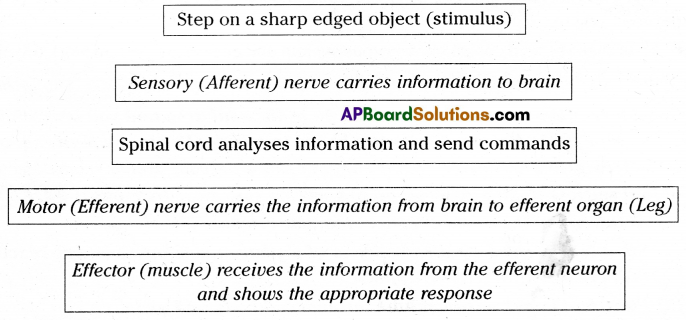
![]()
![]()

![]()

![]()
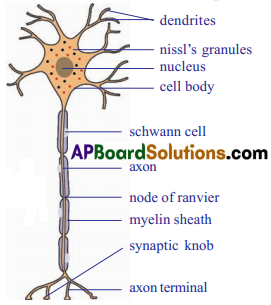
![]()

![]()


![]()

![]()
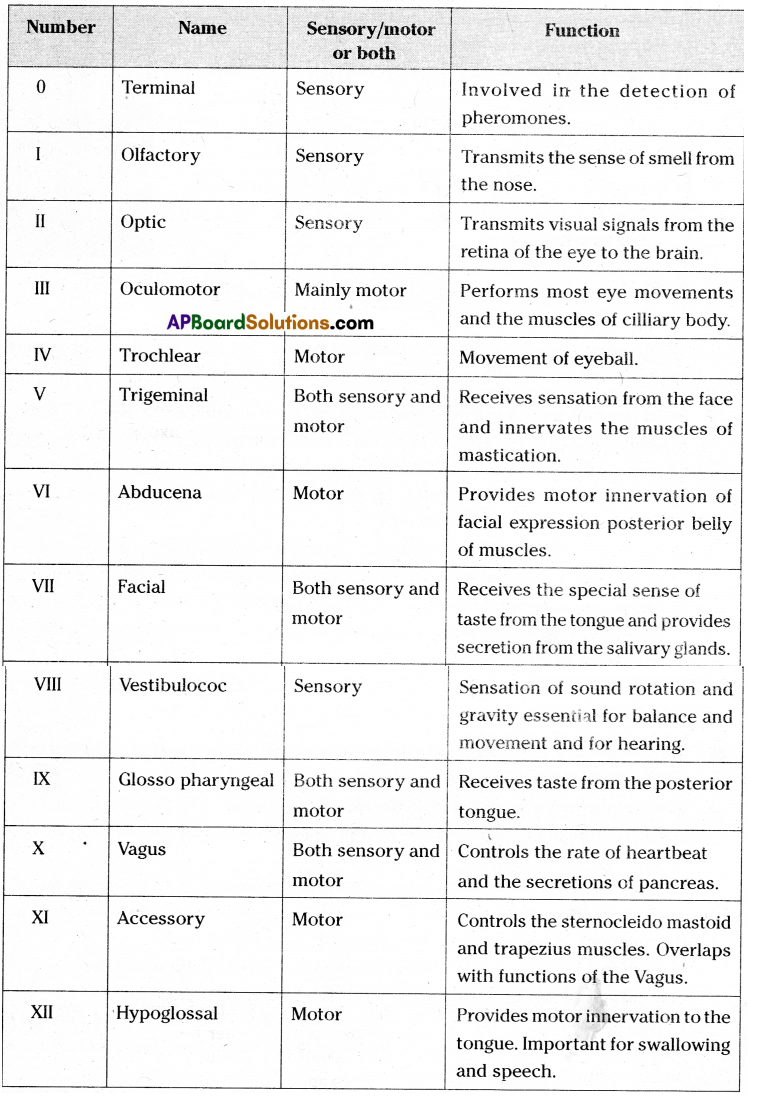
![]()

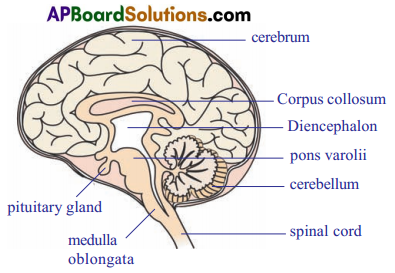
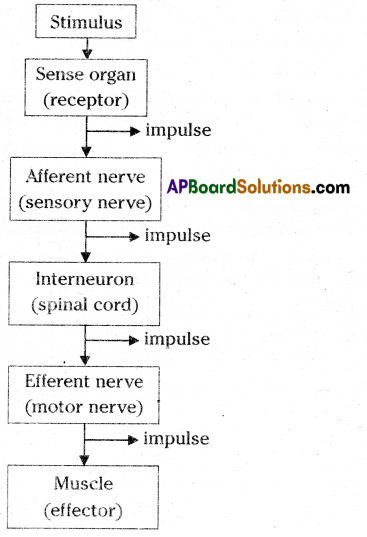
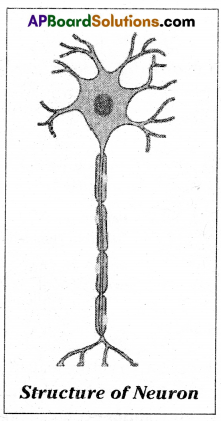
![]()


![]()
![]()
![]()

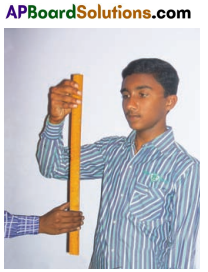
![]()

![]()


![]()

![]()




